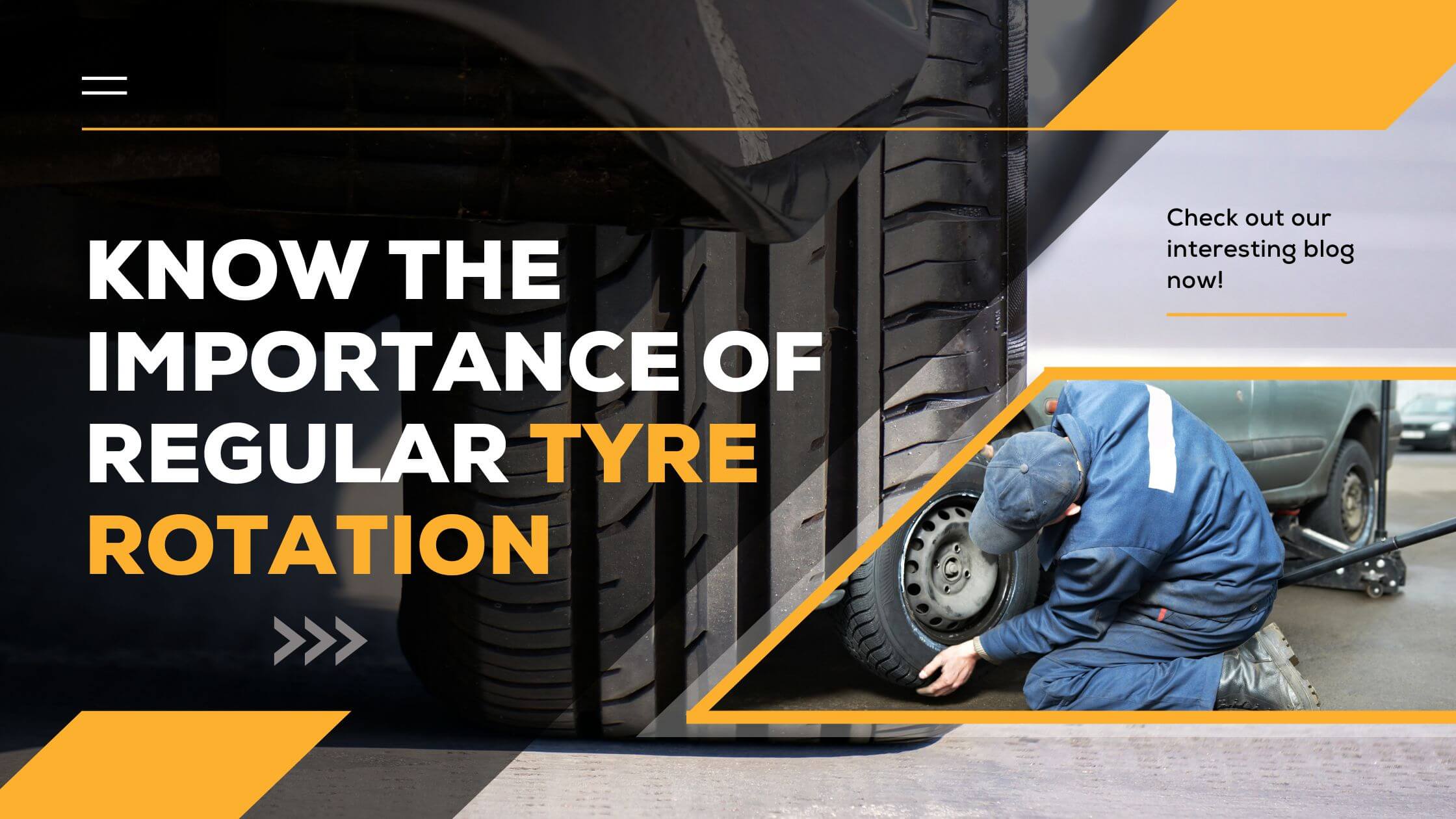Have you even listen the term “Tyre Rotation” but don’t know what is it, its benefits and how often you should get the tyre rotation service? Read the blog till end to know all the major aspects.
We all know that only your car’s tyres make direct contact with the ground? All of the other parts assist your car move by delivering the tyres with power.
We may argue that the tyres are a significant part of your car. They control your steering, brakes, and acceleration and absorb any bumps in the road. As a result, it’s critical to keep them in good operating order. Tyre rotation is a crucial part of tyre maintenance and safety. It involves periodically shifting your car’s tyres in predetermined patterns from front to back or side to side. Rotating them may be necessary for your tyres to remain protected by the warranty.
According to the National Highway Traffic Safety Administration (NHTSA), around 11,000 tyre-related incidents happen each year, many of which are caused by tyre failure from uneven wear. Hence, NHTSA advises drivers to rotate their tyres as part of their maintenance schedule.
Let us now understand what tyre rotation is and why it is essential for your car’s maintenance and safety.
What Is Tyre Rotation?

Tyre rotation refers to the periodic shifting of each tyre’s place on your car. You should rotate your tyres regularly to visually check the air pressure, check them for damage, measure the tread depth and have them rebalanced if you hear any vibrations.
You should rotate your tyres frequently, depending on your car. We know that every vehicle is unique, so it is advised that you consult your owner’s manual to find the ideal frequency for tyre rotation. On the other hand, if you have a flat tyre, you will need to get a brand-new set of tyres.
Tyre Rotation: Benefits
You must ensure that you regularly take your tyres in for maintenance and repair if you want to keep them in top shape. Rotating a car’s tyres is an excellent technique because it helps to even out the wear on all of your tyres. Read along for more tyre rotation benefits.
Rotating your tyres might boost your car’s fuel economy. When your tyres are unevenly worn, they won’t be able to keep even contact with the road, which will cause more friction. As a result, your engine must work harder to move your car and consume more fuel.
-
Long-Lasting Suspension And Tyres
In addition to making your tyres wear out more quickly, uneven tread wear can cause vibration that can harm your suspension system. The longevity of your tyres and suspension can be increased by routinely rotating your tyres.
The many functions your car’s tyres carry out cause them to wear at different rates. You can keep a more even wear pattern on your tyres by rotating them. An enjoyable ride is made possible by tyres that have been worn evenly.
A tyre rotation can improve your tyres’ traction on the road by preventing uneven tyre wear. As a result, you’ll be able to drive more safely through abrupt corners and on snowy and rainy roads. This will also allow you to brake suddenly, lowering your risk of an accident.
Signs You Need A Tyre Rotation
Inspecting your tyres with a professional is the best approach to determining whether to rotate them. To further indicate that your tyres require rotation, keep an eye out for these warning indications.
In ideal circumstances, driving your car shouldn’t cause any strange vibrations. Even if you only detect vibrations at higher speeds, your car’s vibrations could indicate that the tyres are wearing unevenly. The steering wheel is one location where the shaking might occasionally be noticeable.
-
Uneven Wear Of Individual Tyres
Check your tyres for uneven wear, which could point to misaligned wheels or the need for tyre rotation. If you look closely, you can detect tiny horizontal bridges between your tyres’ grooves. The horizontal bars go closer to being flush with the tyre treads as your tread is worn down. However, if you notice that one side of your tyre’s treads or bridges is eroding faster than the other, have it checked.
-
Uneven Wear Of Tyres From The Front To The Back
Another thing to consider is the difference in wear between the tyres on the front and back axles. Each tyre can spend time in front and rear axles thanks to tyre rotation, which evens out the wear pattern.
How Often Is Tyre Rotation Necessary?
A general rule of thumb is to schedule a tyre rotation for your car every 5,000 kilometers if you’re unsure when it’s needed.
The tyres’ rate will vary depending on whether your car has a front, rear, or all-wheel drive. The driven wheels must perform more work and frequently show faster wear rates. For instance, a front-wheel-drive car uses its nimble front wheels to steer, brake, and transmit power to the ground.
By rotating your tyres, you offer them a chance to wear more evenly and lengthen their lifespan.
You should rotate your tyres every 3000 to 5000 miles, at least each time you get your oil changed. Plan on having your tyres rotated at least once every six months, even if your owner’s handbook specifies that your automobile doesn’t require new oil that frequently.
What Happens To Tyres If I Don’t Rotate Them?

Tyres tread can deteriorate unevenly without routine rotation, producing a harsh and potentially unstable driving surface. Ultimately, this kind of tyre tread degradation may make you less safe while driving; consider hydroplaning, heat buildup, the more dangerous punctures, and blowouts, and inadequate grip in snow and ice.
According to an NHTSA report, insufficient tread depth is to be blamed for more than 25% of all tyre-related auto accidents. Consumer Reports also discovered that up to 50% of all passenger cars on the road had at least one treaded tyre.
To prevent accidents and avoid punctures and blowouts, it is advised to get your tyre rotated. Tyre rotation cost is just about $30 to $75!
Conclusion
Flat tyres, punctures, tugging, sliding, and other problems that impair your driving skills are easily noticeable. We typically only give tyre care and maintenance our full attention when any such issue arises. Mobile mechanics in Perth handle all your car-related issues and mobile tyre fittings. To replace your tyres, they have a selection of affordable tyres. Search for “car tyre repair near me,” “tyre shop near me” or “tyre fitting near me” to find a nearby place where you can get your tyre repaired or replaced.
However, if you take good care of your tyres, you might be able to avoid problems altogether. Tyre rotation is one of the most crucial maintenance tasks you should schedule regularly. Although it can seem insignificant, changing the tyres on your car is more significant than you may realize. Tyre rotation allows you to move each tyre’s position on your vehicle routinely. Without routine rotation, tyre treads can wear unevenly, creating a rough and unstable driving surface. If you’re unclear about when to rotate your car’s tyres, a general rule of thumb is to plan one every 5,000 kilometers.
Common FAQ’s
1. Does tyre rotation affect alignment?
No. tyre rotation and alignment are unrelated. However, it is advised that you get your alignment checked regularly. You can save time and money by completing your alignment simultaneously with your tyre rotation.
2. Is it OK to rotate tyres every 10000 miles?
A general rule of thumb is to rotate your tyres every six months or for about 6000 to 8000 miles. But it depends on the car you drive and the information given in the vehicle’s manual.
3. Can I rotate my tyres myself?
You can learn how to rotate tyres and perform the work as a do-it-yourself project at home, even though many people opt to have this maintenance performed by professionals. Or you can also call mobile mechanics to visit your place for tyre rotation service.
4. How long does tyre rotation take?
While many people are concerned about how long a tyre rotation takes, the truth is that it usually only takes a little under an hour.
